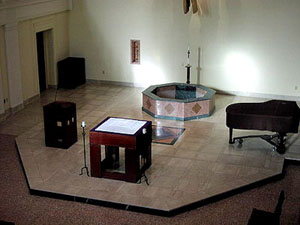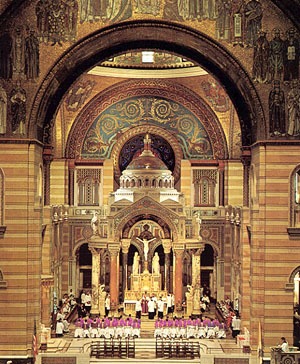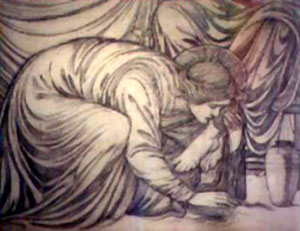 |
Consequences of Vatican II
The Role of Real Estate Liquidation
in the Decline of the Archdiocese of N.Y.
Michael Ryan

Part I: Background
The current “parish realignment” policy of the Archdiocese of New York brings to mind an item of history, within living memory, that many have forgotten.
In the 1960's, under Francis Cardinal Spellman, the main chancery office was located in the Villard Houses, three mansions that face the back of St. Patrick’s Cathedral on Madison Avenue. Catholic Charities had its own office building just north of Gramercy Park on Lexington Avenue and 20th Street. Cathedral Girls High School was on 50th Street and Lexington. These three pieces of prime real estate would today be worth close to a billion dollars. Chancery officials proposed to Cardinal Spellman that he sell this property and consolidate the offices and high school into a single site. Several options were considered, among them a site occupying much of the block on 10th Avenue between 50th and 51st Streets, which the Board of Education used to park school buses overnight. The City offered it to the Archdiocese as a virtually vacant piece of property, ripe for redevelopment.
But that site was located in Hell's Kitchen, which was still the teeming tenement neighborhood of movie fame. Such a development project by the Archdiocese, bringing its offices, and a private school would have brightened up the neighborhood considerably. Even though the offer of the site was a virtual “steal,” the chancery officials did not fancy the neighborhood. Instead they focused their interest on an end-block site in the up-and-coming, eastside midtown block of 1st Avenue between 55th and 56th streets. It was then occupied by the Church of St. John the Evangelist, a magnificent German Gothic edifice built in 1886, along with its school, rectory, and convent. Chancery officials approached the pastor, Msgr. William O'Connor, with the plan. He refused to go along with it.
 
Catholic churches across the country are being demolished under different pretexts. Is there a new conception of the Church behind this destruction? - Fort Leavenworth Lamp, April 29, 2004 |
Since Msgr. O'Connor was the permanent rector of the parish, he could not be removed except on formal canon law charges of heresy, financial misdeeds, or gross moral misconduct. As none of these applied, he could not be ousted and replaced with a cleric favorable to the plan. In order to effect such a thing, a majority of the officers of the parish corporation must agree to it. Those members would consist of the Archbishop, the Vicar General of the Archdiocese, the pastor, and two lay trustees from the parish.
The lay trustees were pressured to go along with the plan. Despite the outrage of the parishioners and parents of the students of Cathedral High School, all of the parish buildings were to be razed. The archdiocesan officials argued that the church was “underutilized,” even though it had a regular Sunday attendance of 2,500, and “not suitable for the liturgical requirements of Vatican II.”
The parishioners attempted to protest and petition the Archbishop (now Cardinal Cooke) lawfully, but their effort was in vain. By the fall of 1969, the last stones of that beautiful church fell to the wrecker’s ball. A temporary chapel was set up for the parish, which had a Sunday attendance of 700. Many of the laity had walked away, never to return. Msgr. O' Connor consequently had a series of strokes that incapacitated him. He resigned and was replaced by one of the key players in this scenario, Msgr. George Kelly (former Secretary for Education for the Archdiocese).
In 1972, the new multipurpose chancery office/high school/church was built. The new church, as should be expected, was everything the old church was not: crass, ugly, and cramped, with little genuine art or beauty to it.
What of those other properties? The old chancery office buildings, the Villard mansions (now part of the Helmsley Palace Hotel) were sold for millions of dollars. The Catholic Charities building was converted into condominium units, and where the Cathedral High School once stood a high-rise office building now stands. Both also sold for millions of dollars.
Part II: How is Christ served?
The obvious answer is that Christ is not served by decimating the patrimony of the Church, which demoralizes the very souls she is supposed to save. So we must ask why.
Does the Archdiocese need money? In an absolute sense, yes. There has been a gradual but serious falloff in church attendance and membership. The migration to the northern suburbs has only resulted in temporary local growth. But it will be short-lived, as any survey, or peek into the door of a church on Sunday morning, will show. Younger people generally do not go to church after they graduate high school. So any increase in suburban church attendance merely reflects a shift in population, not absolute growth. There are data to show that the children of the suburbs do not move into the same neighborhood as their parents to raise a family.
Taking that peek in the door of the suburban church will also frequently show that the attendance is a pyramid that is top-heavy with the elderly. Within their means, they contribute well, for this is what they were taught to do. Many of them bequeath money to the church. The middle-aged members form the next largest group. There are far less of them than the elderly, but they also donate generously. The smallest group, at the tip of the pyramid, consists of young singles and couples with children. They are usually “strapped” economically and usually can little afford to give as well as the previous generation in the same age-range.
In a nutshell, as much as 40-50% of the active, contributing flock of many suburban churches are made up of the elderly, who will not be around ten years from now. Many of these currently wealthy northern parishes will shortly see their bottom drop out. This will mimic what happened to many of the churches in Manhattan and the Bronx just a few short years ago. It will be a very hard fall, as those northern parishes are paying for everything else in the Archdiocese.
Making the situation even more ludicrous, Cardinal Egan says that the proceeds of the sales of any properties will be used to fund capital expansion projects in the parishes of the northern suburbs. If these parishes currently have the ability to generate the greatest amount of income, why do they need money? If they truly needed new or larger church buildings, can they not raise the necessary funds themselves? This would be almost funny were not the planned destruction of historic churches in Manhattan to fund such lunacy so tragic.
We are describing a disaster that is not merely inevitable, but it is upon us. What the Archdiocese of New York needs more than money are people in the pews. Without them, there is neither the need for money nor any possibility of raising it.

Above, the sanctuary of the Paulist Chapel in Boston makes a sharp contrast with the beauty and splendor of pre-Vatican churches - below, the St. Louis Cathedral sanctuary.

|
Those of us old enough to be taught by traditional nuns were taught that Christ does not need beautiful churches, vestments, works of art, etc., to save souls. We could say Mass on a rock in the woods, and it would have the same spiritual effect. These material goods, the patrimony of the church, are tools to carry out the mission of the church, tools that are to be cherished as sacred, as a great gift. What is this mission? The salvation of souls. Thus the Church should always be in an expansionist mode, casting out her net to attract more and more people to the Christ she worships and serves.
The purpose of a pastor, and therefore of a Bishop, is to minister to the flock he is given and to prudently use for the care of souls the resources that are provided to him for that purpose. Which souls? The few hundred who attend a smaller Manhattan parish on Sunday? No, all 25,000 people who live within its boundaries, no matter what their faith or lack thereof. According to the Church, he is responsible for all of them before God. He will not win over all of them, to be sure. Perhaps he will only be able to touch a few lives. But did he pray for them? Spend a night sleeping on the floor in penance for them? Do any charity to them? Or did he spend his time in the Hamptons?
The Church in New York has done a miserable job of attracting new pew-sitters to worship the Christ Whom they profess to serve. Blaming pop culture is to make a poor excuse. So are complaints of a lack of money. In the past 35 years, the response of the Church in New York to changing demographics and culture has been to close the doors to most of their church buildings except for a few hours a week.
Churches have been ruthlessly “wreckovated” for bizarre notions of liturgical updating, destroying their beauty, and driving people away. In most parishes the care with which the Mass is offered, including the ceremonial music, is a disgrace and does nothing to attract the curious soul that might consider joining. The clerical sex scandals and the miserable way they have been handled have done nothing to attract more pew-sitters, but have driven some away.
If the Archdiocese were a business, the need for more customers would be clearly seen, for that would increase cash flow in both the short term and the long term. Selling off branch offices and real estate, piece by piece, to serve a rapidly shrinking client base will, unless the client base is increased, only result in the organization’s fiscal collapse sooner rather than later. This is the description of virtual suicide. A cardinal rule of the management of non-profit organizations is never to sell real estate, for you will not get it back. Money can always be raised, but real estate, once gone, is gone for good. Its sale signals downsizing and auto-destruction.
Are we dealing with misfeasance or malfeasance? That is, are we dealing with unintentional incompetence or deliberate mismanagement? Are we witnessing “mistakes,” or the implementation of an agenda?
Quo vadis, Cardinal Egan?
Part III: The Judas factor
The most difficult thing to understand about Judas is that Christ chose him to be one of His Apostles, knowing full well that he would betray Him. Since Christ was God, He created Judas. Also, because He was God, he foreknew the outcome of everything.
Judas was one of the most educated of the group, spoke multiple languages, and is believed to be the one who kept the accounts, bought food, and handled the material needs of the small group that comprised the embryonic Church. He disagreed with Christ, wanted a Christ on his own terms. Satan entered his heart, and while he walked with Christ, he no longer believed. He could have left Christ at any time and was free to do so. But, no, he chose to stay within the company of the Apostles, and participated in everything they did. And, as we know, he betrayed Him for 30 pieces of silver. The connivance and treachery of Judas directly resulted in the mock trials, torture, and awful death by crucifixion of Jesus.
Connivance and treachery by one of Christ's own, from within His organization, called by Christ to be part of it.
Some have observed that the Church is troubled by a “Judas Factor” today. It is an attack not merely from without, but also from within, by those whom Christ chose and were consecrated to His service. Part of a conversation overheard between Hans Küng and Edward Schillebeeckx, two radical, heretical theologians, during a meeting in Rome of Vatican II says it all: “Oh no, we are not going to leave the Church this time; no, this time we are staying in.” A spirit of revolt from within.
What are the characteristics of this “Judas Factor”? To start with, there is a gross distaste for devotion to God. Judas criticized Mary Magdalene for washing Christ's feet with oil, a sign of her devotion and love for Him for saving her. Priests during the last 35 years have shown a marked hatred for popular personal devotions, private prayer, the Rosary, Stations of the Cross, and all that brings spiritual comfort.

Judas' notion of a poor and miserablist Church is the model for the progressivsts today |
As well, Judas criticized Mary Magdalene for spending money on the oil just mentioned with which she honored Christ, saying the money would have been better used “for the poor.” Judas's concern was false, and Christ rebuked him for it. How many priests now constantly blather about “peace and justice” and the “needs of the poor,” yet show little care for the poor as they, the priests, take their vacations in the world’s fleshpots, using the people’s money earmarked for the support of the Church and the care of the poor?
Judas left the Last Supper to betray Christ. We have far too many priests with no love for the Mass, who say it with gross disrespect in word and action. They encourage a cacophony of noise, bad music, unseemly levity, all designed to strip away the sacred.
Judas was one of the most learned of the Apostles, but learned only in worldly matters. Even so, many of our priests are too caught-up in worldly knowledge and know little of the things of the spirit, and their inability to preach or explain the truths of the Faith shows this. That they have no faith is equally clear.
Judas betrayed Christ to the Temple authorities with a kiss. How many of our priests begin Mass by kissing the altar, yet show no respect for the altars upon which Christ is sacrificed in the Mass by destroying them in horrific “renovations”?
The Church is defined as the Mystical Body of Christ, yet that Body, even as its Lord, is subject to disgrace, shame, ridicule, and torture of mind and spirit by the horrific sex scandals.
Judas did not care about the consequences of his traitorous actions either to Christ or to His followers. Nor did he care about the future. So too, the clerical Judases care not if their actions offend a layperson, if he or she ever returns to Church, or if his or her soul is saved. No such concern is evident in their demeanor, speech, or actions. Nor do they seem to care if they offend Christ.
For these Judases evidence no love for God or for their fellow man. It does not matter to them that if you merge two parishes, a large percentage of the people involved in that merge may never go back to church. It does not matter. The agenda was served.
It does not matter if money is improperly managed. Is more needed? Then get the people to “tithe.” Tell them it is their obligation to give you more. Do then what you want with it: it’s yours to spend as you please. After all, you are a priest, the wise man of the village. The peasants owe you as much. If they have the effrontery to ask for an accounting, just shush them as if they were children. Filling the parish and Archdiocesan coffers serves the agenda.
Should you expend effort to preach Christ to those who do not know Him? No, that is too much work, and to proselytize is beneath you. It is not part of the agenda.
It does not matter if you are frequently absent from the parish, whether on vacation, or dining out, or busy when laity are begging to see you for spiritual counseling. In the words of a Judas Priest: “It’s hard to be present.” And in any case it’s not part of the agenda.
It does not matter how you say Mass, or what vestments you do or do not wear. “Hey, I can do what I want. I’m a priest.” That fits the agenda.
For what this all comes down to is this: no priest could do these things or think in such a mode if he truly believed in or loved God. These attitudes display contempt for Christ, his Church, and for the people. Satan has truly entered the heart of the Judas Priest, and caused him to lose faith and to commit sin. And that sin is the primordial sin of pride, from which flows greed, sloth, envy, lust, and all other sins and human failings. Pride causes a Bishop and his priests to connive to sell the patrimony of a Diocese for questionable moral and managerial reasons.
Christ is the opposite of pride. He is humility, love, and mercy personified. The solution to this Archdiocese’s clergy problem is Christ. In seeking Him in deep personal prayer they could find the heavenly graces to learn humility, love, and mercy, and thus seek and pray for the grace of right reason to do their job with the mind of Christ.
But, that's not part of the agenda.
The pleasure TIA has to publish collaborations of our guest columnists does not imply
that it endorses all the opinions expressed in their articles.
Return to TOP

Posted June 14, 2004

Related Topics of Interest
 Closing Churches, Selling Diocesan Palaces Closing Churches, Selling Diocesan Palaces
 Closing Churches: Incongruent Arguments Closing Churches: Incongruent Arguments
 The Real Estate Liquidation in the New York Archdiocese The Real Estate Liquidation in the New York Archdiocese
 Do Not Close Holy Trinity Church Do Not Close Holy Trinity Church
 List of Churches Closed in the Archdiocese of Boston List of Churches Closed in the Archdiocese of Boston
 Ratzinger's Dream for the Future Church Ratzinger's Dream for the Future Church
 Is the Catholic Crisis Really Explained? Is the Catholic Crisis Really Explained?
 The Catacomb Pact against Pomp and Ceremony in the Church The Catacomb Pact against Pomp and Ceremony in the Church
 The State of Mind that Generated the Revolution The State of Mind that Generated the Revolution

Related Works of Interest
|
|
Vatican II | Hot Topics | Home | Books | CDs | Search | Contact Us | Donate

© 2002- Tradition in Action, Inc. All Rights Reserved
|
 |
|
